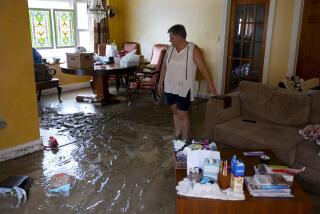Midwest flood woes head south
IOWA CITY, IOWA — With floodwaters receding in much of Iowa, the destruction moved downstream Tuesday as emergency crews and residents raced to bolster the levees that protect dozens of Mississippi River towns.
National Guardsmen joined hundreds of volunteers in filling sandbags and reinforcing earthen barriers in southeastern Iowa, eastern Missouri and western Illinois. The mood grew frantic when several major tributaries to the Mississippi spilled their banks and the river surpassed record flood levels, swamping towns along the way.
Early Tuesday morning, more than a dozen sandbagging volunteers and a motorist had to be rescued when a levee was breached in Carthage Lake, Ill., about 70 miles southwest of Davenport, Iowa.
The advancing water swamped farmland and the community of Gulfport, Ill., leading officials to shut down the Great River Bridge, which connects that part of the state to Missouri.
In Burlington, Iowa, postal workers and schoolteachers waded through waist-deep, muck-laden waters, dragging plastic sheets and lugging sandbags in their effort to hold back the flow.
In La Grange, Mo., residents watched helplessly as the Mississippi filled the streets for the third time in 15 years. The post office was flooded, and City Hall was in danger. So were scores of homes in the town of about 1,000, whose residents were forced to rebuild after floods in 1993 and 2001.
“A third time? I can’t do it,” a weepy Harold Ludwig, 68, the town’s former mayor, told the Associated Press. “I’m sorry.”
Part of the problem, said U.S. Army Corps of Engineers spokesman Ron Fournier, was that it was nearly impossible to predict which barriers -- such as the sandbag and earth-based ones being furiously built along the Mississippi -- might crumble beneath the mounting water pressure. Officials don’t know where to focus valuable time and energy.
“That’s a crystal ball that nobody has,” Fournier told reporters.
President Bush plans to visit Iowa on Thursday to tour the disaster region. At a news conference, he said funds would be set aside to help flood victims. “I unfortunately have been to too many disasters as president,” Bush said.
Though state and federal experts were still assessing the damage to large swaths of the Midwest on Tuesday, they said the impact would be substantial.
For more than a week, floodwaters have spread across the nation’s Corn Belt, preventing farmers from planting soybeans and damaging a corn crop had just started to sprout. Analysts estimated that Iowa, Illinois and other corn-growing states might produce 15% less than last year. Some believe the shortfall will be larger.
The storms have hit Iowa especially hard. Gov. Chet Culver has declared 83 of the state’s 99 counties disaster areas. An estimated 38,000 people are homeless.
State officials gauge the damage to Iowa’s corn crop alone at more than $2.7 billion, with the cost of repairing and rebuilding Cedar Rapids -- the state’s second-largest city -- expected to be at least $1 billion.
In areas that have been flooded for days, concerns about contamination were growing as sewage, farm chemicals and fuel have flowed along the waterways.
In Palo, an eastern Iowa hamlet of nearly 1,000 people that was submerged by the Cedar River, the mud that has painted thick streaks across hundreds of homes stank of manure and mold.
At one checkpoint on the outskirts of town, volunteers with the American Red Cross pleaded with weary residents to take the time to get tetanus shots.
“They’re talking about whether I’ve had my shots for hepatitis. Are you serious?” said Randy Moser, 37, as he helped his uncle sort through rusting garage tools.
Oil and mud covered his hands and streaked his face.
“How am I supposed to worry about something like that at a time like this?”
--
More to Read
Sign up for Essential California
The most important California stories and recommendations in your inbox every morning.
You may occasionally receive promotional content from the Los Angeles Times.









